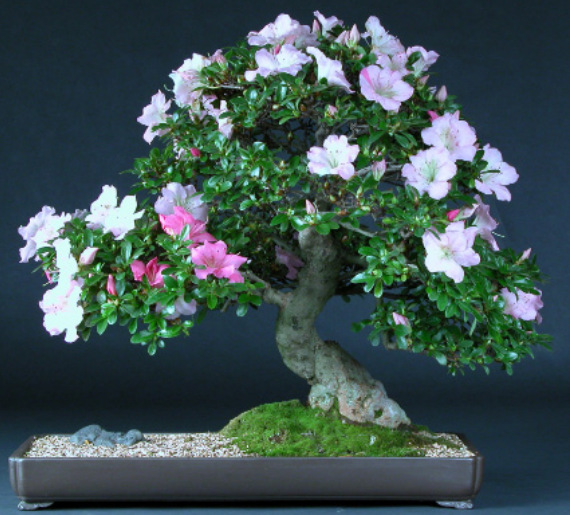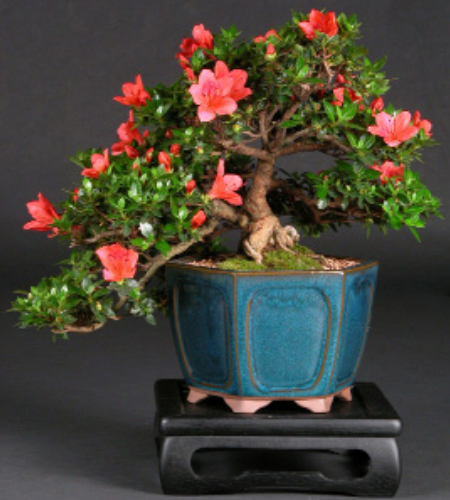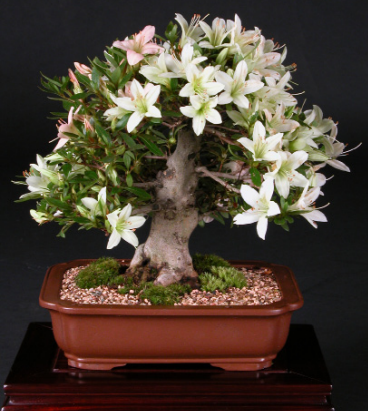The azalea, genus Rhododendron indictum, is one of the most sought after and satisfying of all bonsai subjects. First and foremost among its reasons for popularity is that it flowers spectacularly. In addition, the plant adapts well to container cultivation, trunks up substantially in a relatively short period of time, adapts well to substantial root pruning and will bud back with exceptional vigor on old wood. Its primary disadvantages for bonsai is that the branches are relatively brittle and the bark thin and tender. For this reason, great care must be taken when wiring and shaping branches. Softer aluminum wire is a good idea as is the liberal use of padding such as raffia.
Azaleas, as the botanical name implies, are members of the Rhodendron family. In fact, there is no real botanical difference between the two species. Azaleas, however, are smaller leaved in stature, thus making them prime candidates for the bonsai artist. Generally speaking, Azaleas are divided into two kinds… Satsuki and Kurme. Satsuki is a Japanese term which means “fifth month”, or late spring… the time that most, but not all, satsuki flower. Satsuki have become the most popular for bonsai followed closely by the Kurme varieties. There are literally hundreds of different varieties of both species, mostly grouped according to the shape and colors of their flowers. Because of their ability to bud back readily on old wood, azaleas are very “collectible”, particularly from overgrown foundation plantings around private homes. Collected trees with massive trunks can be cut back almost to stumps and will still develop hundreds of new shoots and branches if cultivated properly.
Styles: Almost any style bonsai can be designed from an azalea. Most common however seem to be informal uprights, multitrunks (partly due to the plants growth habit) and cascade.
Transplanting: Azaleas like a somewhat acidic soil content. It is therefore advisable to add a little more peat to your potting mixture when transplanting azalea. Azaleas grow fine fibrous feeder roots with very few larger tap roots. They withstand substantial root pruning, although it should be done in the early spring, just before or after the tree finishes flowering. If you choose to transplant before the tree flowers, it is advisable to remove all flower buds so as to avoid placing an unnecessary strain on the plant. The roots systems grow vigorously and will probably need transplant and root pruning ever two years.
Water and Light Requirements: The tree should be watered at least once a day throughout the growing season to insure that the soil mass remains moist… but not soggy. Azaleas do not like to dry out. If allowed to do so, the fine fibrous roots will soon desiccate and die. They will do well in a bright location that is filtered from direct sunlight or with about half a day of direct sunlight. We keep most of ours under 50 percent shade cloth.
Feeding: Feed your azalea at least every other week in the spring time until the flowering period is over. Thereafter, monthly feedings will be adequate. You should use an acid based fertilizer such as Mir-acid. In the late summer or early fall, reduce nitrogen from the fertilizer mixture and begin increasing the amounts of phosphorus and potassium. This will help the tree to set buds and blossoms for next season.
Winter Care: Azaleas are generally very hardy in the Carolina’s. Once dormant, they should be placed in a protected location and mulched up the rim of the pot. Take care where you store your azaleas in winter. Mice and rabbits find the soft bark of the azaleas particularly tasty. For those who want to keep their bonsai indoors year-round, the azalea is a willing subject. A cool window and plenty of light is the rule for keeping an azalea indoors during the winter months as is the need for frequent misting and high humidity.
Shaping and Maintenance: As mentioned before, azaleas have particularly brittle branches and tender bark. Aluminum wire is somewhat softer and will work better than copper. Indeed, aluminum wire was specifically developed for use by Japanese azalea growers, although today, it is widely used for all types of bonsai. Plastic tape or raffia can also be used to protect sensitive bark. It is important to make clean cuts with a sharp tool and to seal all larger wounds to the tree with Lac Balsam or some other wound sealant immediately. After the tree finishes flowering, it is important to remove all the dead flowers at the flower’s base, to prevent the tree from forming seed pods. Instead, the tree will begin forming new leaves.
Here are some popular varieties of azalea you may want to consider:
Satsuki ‘chinsan’ – small deep pink flowers with red throats
Satsuki ‘hakurei’ – creamy white flowers
Satsuki ‘kaho’ – large trumpet like flowers in pale soft shades of pink
Satsuki ‘kazan’ – small red flowers
Satsuki ‘kinsai’ – deeply cut red flowers
Satsuki ‘ korin’ – small pink flowers
Satsuki ‘wakaebisu’ – salmon pink flowers
Satsuki ‘narihira’ – white flowers with purple pink margins
Satsuki ‘aikoku’ – white flower with pink stripes




